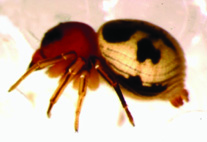Abstract
The spider genera Mystaria Simon, 1895 and Paramystaria Lessert, 1919 are revised (Mystarini: Thomisidae). About 400 individuals were studied. The approach followed was classical taxonomy using illustrated sexual dimorphic copulatory characters and described morphological characters, photographed or measured. Paramystaria is considered a junior synonym of Mystaria, based on similarity to the type M. rufolimbata Simon, 1895 but with the exclusion of M. unicolor Simon, 1895, a species last studied in 1895. Mystaria unicolor is re-described and placed in a new genus, Leroya gen. n., together with L. silva sp. n. (♂♀, DRC) which is recognised as the type species. Mystaria now contains 13 well-defined species, four of which are in new generic combinations. Four males are described for the first time, and eight new species. Re-described species include M. flavoguttata Lawrence, 1952, M. lata Lawrence, 1927, M. rufolimbata and M. variabilis Lessert, 1919. Subspecies elevated to species level include M. occidentalis Millot, 1942 and new species descriptions include M. budongo sp. n. (♂, Rwanda, DRC, Uganda), M. irmatrix sp. n. (♀♂, Mozambique, South Africa) M. lindaicapensis sp. n. (♀♂, South Africa), M. mnyama sp. n. (♀♂, South Africa), M. oreadae sp. n. (♀, Rwanda, DRC), M. savannensis sp. n. (♀♂, Botswana, South Africa, Zambia, Zimbabwe), M. soleil sp. n. (♀♂, Uganda, Kenya) and M. stakesbyi sp. n. (♀♂, Ghana, DRC, Kenya, Rwanda, Tanzania, Uganda). The insufficiently known taxa Paramystaria decorata Lessert, 1919 and P. variabilis delesserti Caporiacco, 1949 are also transferred to Mystaria. Keys are provided to species and related tribal genera, with geographic distributions of species recorded. Revisions of more genera are needed, in particular of those genera related to Mystarini, before phylogenetic relationships can be considered.

